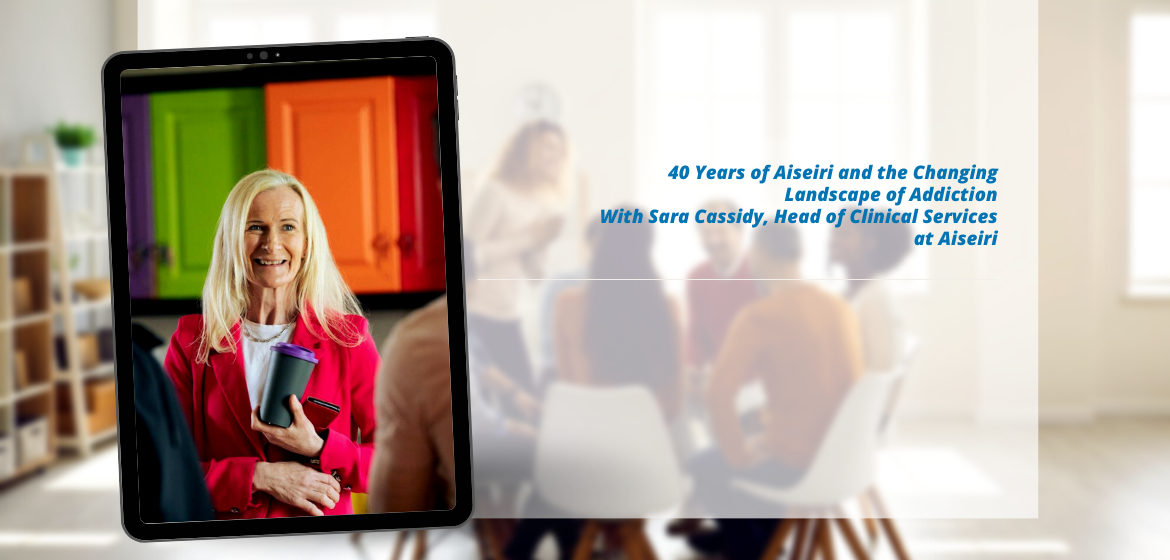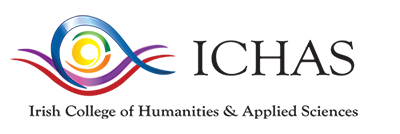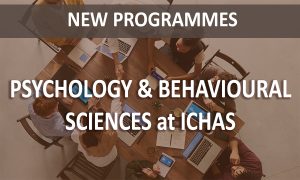
40 Years of Aiseiri and the Changing Landscape of Addiction
In this episode, we are joined by Sara Cassidy, head of clinical services at Aiseiri. She talked about the organisation as it celebrates its 40th anniversary, the services they provide, and how addiction has changed in recent years.
Tell us a bit more about Aiseiri
So Aiseiri is an extraordinary organisation. It was established 40 years ago by sister Eileen Fahey originally and based in Cahir Tipperary. It was set up originally because there was such a revolving door for people struggling with addiction, going into mental health services like the psychiatric services in Clonmel and coming back out after being detoxed and heading straight back in again very quickly.
So treatment was really necessary and Sister Eileen actually ended up going to Hazelden in America to see the gold standard of treatment if you like. She had also worked in Rutland, Dublin and then she came in and established the service in Tipperary, which started really at a grassroots way with volunteers and fundraising. It’s grown massive at this point, where we’re now in four counties but we’re a national service so our clients come from all over Ireland and even beyond and we’ve two adult treatment centers there in Tipperary and in Wexford. We have an adolescent service which is in Kilkenny and then we’ve secondary treatment services for men and women over 18 in Waterford. So it’s grown and the 40th anniversary is this year this September
It sounds very much kind of like with Aiseiri they have identified with under-18s you can’t have them being treated in the same setting as adults, the approach has to be different.
No doubt about that though, Danny, and I mean, it’s extraordinary when you consider that we’re a 12-step treatment center, that’s our philosophy it comes from Hazelden originally in the Minnesota Model. There’s nowhere in Ireland for young people, under 18s teens to get the abstinence-based model other than Aiseiri it’s extraordinary. We’re the only center in the country that can do it and for the adolescents, they desperately need a different service. It’s a longer service. They’re with us for seven to nine weeks, as opposed to four with the adults and we’re working with people that are 15 years old, up to 21 and the care that they need is completely different. And the treatment itself was very holistic and client-centered and based around the young person and their family.
It’s just not feasible to do it in the adult services, the adult services the other very big difficulty that Aiseiri identified, there’s a range and those that might have been suffering from mental health issues and addiction have ended up in say psychiatric wards in the hospitals and under 18s, that’s not a safe place for them either. So for others, then they may present with addiction and the Psych Services don’t want to see them and vice versa they might present to addiction services, mental health, and substance misuse teams didn’t want them. So they’re falling between two cracks and it was just, you know, awful for those individuals. So Aiseiri been working with dual diagnosis for many, many years and our teams are really multidisciplinary and comprehensive where we can meet their needs, with consultants, psychiatrists, level two GPS, nursing teams, care workers, addiction counselors, psychotherapists, so it’s a very, you know, holistic type of team that will work with the adolescents and then a lot of milieu therapies, because obviously, they need education and they need various life skills and it’s not rehabilitation when it comes to the young people, because realistically, it’s habilitation, you know, they’re there, they don’t have something to rehab but ability back to because oftentimes they haven’t had a chance to develop the life skills that maybe adults have accomplished over the years.
So it’s a completely different cohort. Now in saying that it’s been established since 1998. But in recent years, the complexity of young people has grown remarkably, or whether or not you could debate is it that our awareness or understanding has improved in recent years. But for sure, the complexity has increased. So many of the young people are presenting now with dual diagnosis with, you know, very complex needs, in that their mental health may have been affected by the substances that have been using, where in Aislinn, and the adolescent unit, the primary substance still is cannabis, which, for the young people with their developing brains, if they’ve been utilising that over consistently over quite a number of years, the mental health or psychiatric effects are massive.
So you’re dealing with that piece as well in their development and then often, learning difficulties or being neurodiverse is very common, or maybe we’re much better aware of it nowadays. So that comes into the mix and then you have the family dynamics, family issues, and maybe education issues. So it’s really diverse and very complex, very complex. Now, equally with the adult service and care we’ve seen, the complexity increased dramatically, as well, though, Danny, over the years, so the population in County Tipperary are getting younger. So if you went back for two years, you were probably meeting with people in their 40s, 50s, and 60s that were dealing just with alcohol, and that was it, and they had relatively stable backgrounds, but that’s what they were dealing with and off they go, you know, whereas nowadays, between the multiple substances being misused, adding in the mental health issues, then you have to consider all the various things that have been happening, you know, between the socio-economic issues COVID, all of that things have moved and shifted dramatically in the last number of years,
Are there any particular trends you’re noticing, with addiction in recent years?
The trends are very obvious, like you say, in regards to say substances first and the trends with those will always be in line with accessibility. So wherever there’s accessibility, the trends are going to increase, and the substance will increase dramatically and those presenting for help with that substance as a primary will increase. So for example, in recent times, and you will have heard that on the media, you know, cocaine addiction has gone through the roof and people presenting for cocaine treatment as a result of cocaine has increased dramatically. So that’s around accessibility and the fact that it’s not an urban issue, it’s, you know, absolutely all over the country. Down to the little crossroads in the back of nowhere. It’s everywhere.
So it’s accessibility makes a massive difference. Now, what I will say is as a substance, alcohol still wins in the adult service its still the biggest problem. And then we’ve a diverse range of other substances. We’re continuing to work with red herring, heroin and opiate medications, your marijuana, your benzos you know, they’re very, it’s quite diverse that way. Now as a result of that Aiseiri was ahead of the game in regards to providing detox. So detox services are desperately needed in the country and they’re quite limited and quite difficult to access. So Aiseiri is put in an adult detox in Tipperary and detox for adolescents in Kilkenny, so that’s massive because prior to detox being present in the service was very hard for people to access the service. They couldn’t be clean and sober and had huge difficulty obviously becoming clean and sober to enter treatment. Whereas nowadays you can safely detox off any substance in Cahir Kilkenny. So around the country, even other services would have limited detoxes, whereas we can manage all substances that coming off or substance. So the detox is a big, big issue.
It sounds like the Aiseiri centers are essential, and kind of what they’re providing there. It’s the crucial factor in terms of just helping people to, detox from the substance they’re addicted to.
Exactly and the big part, or the big problem for families and too, and for the clients is that is the risk element. So there’s huge risk, funnily enough in detoxing off of alcohol, or benzodiazepines, they’re the two most risky in regards to the risk of seizure, and seizures can do major damage, obviously, for a person. So those are the two most dangerous and they need to be medically monitored to safely for people to come off safely.
In regards to the risk with heroin, or opiates, it’s far less, and people will find that interesting in that, you know, we would think that heroin is going to be the most dangerous when it’s not at all on, it’s not dangerous. But like you said, there, Danny, you desperately need your own environment or being out of the environment to have a safe detox and support it because it’s very difficult for people.
But it works incredibly well in Cahir and Kilkenny where people will detox safely off the substance they’re hugely supported. And all the fear around actually letting it go with the substance is managed with the person and there’s huge motivation for people then to get into the treatment program, because they’re seeing their peers, having gone through it already how well they’re doing and treatment and it’s just like, it feels like a miracle for them that they’ve actually let go.
The other big trend or big need, is the longevity of services. So for example, if you think of a balance, you know, where you’re weighing scales, the addiction has taken up a massive amount of the weighing scale, and the recovery, only tiny, so it takes time to balance it out and some people really genuinely need longevity. So we have secondary treatment services now in Waterford and that can provide another six months of treatment and support, why is to actually becoming part of the community, again, in education or work or, you know, I mean, life skills improvement again. So that’s wonderful and that’s followed by sober housing. So that can add on another six months, so then you’re talking a full year in recovery, which just gives a person the best chance of remaining in recovery and all the research would show that longevity of support makes a huge difference for outcomes. So our outcomes in Waterford are really, really high with 87% or higher success rate, you know, so it’s amazing to watch. Because if you consider how short primary treatment is, for adults, four weeks, it’s like a drop in the ocean for people that have maybe been in addiction for quite a long time. So it’s great, those pieces that are the biggest moves, I’d say really, that have been necessary.
Drug addiction tends to get most of the press coverage but you look at a kind of alcohol is still number one, and like, unfortunately, it’s almost like it’s partially the Irish. It’s like part of our stereotype that is still associated with it but like you’ve highlighted it really does have an enormous impact on people on people themselves, but also on those around them.
Oh, 100% of Danny, like, it’s extraordinary when you consider that it barely gets any press nowadays, if you like, and it’s destroying people and families all over the country, absolutely destroying them. Now the people coming for help are younger now, which is wonderful, you know, because they’re getting to get their lives back and a great deal earlier. Probably at least 80% of our clients in care would be under 40 nowadays rather than over 40 You know, which is great. So they’re getting a great opportunity to get their lives back.
Even the bit you mentioned earlier about subscription drugs as you’ll often hear when they talk with people who may be addicted to heroin that it started with having a bad injury getting prescriptions and when the prescription was gone, they needed to find something else.
Yeah, and it’s terribly sad when you consider it in that, that somebody, even somebody in recovery, can run into trouble with surgeries or needing pain medication, it can really be a major relapse trigger. But there are so many people like it literally could be your brother, your aunt, your mom, your dad, you know what I mean, it’s anybody can struggle with addiction and you would have seen in the more recent times, where they did a bit of coverage around the codeine-based medications that are over the counter like Nurofen Plus and Solpadeine. Now, that’s still a big problem and we’ll end up detoxing people off of those that have completely destroyed their lives.
So those ones and then, unfortunately, in some of the medical fields, prescriptions are so quite readily available for people. So the first point of call is still, if somebody is struggling, they get a script and you know, the benzodiazepines like Valium, Xanax, and these are quite liberally prescribed for anybody predisposed to addiction, they’re really lethal medication, and they’re actually quite difficult to detox and come off. So it’s horrendous what can happen and people wouldn’t even realize that they’re at risk, you know.
You shared two video shorts on your social channels, and that you’ve been involved in it was one of those ‘Components of recovery & ‘The Click’ how did those come about?
They were extraordinary. Now, Danny, they that came from a lady called Mary Smith, she was working on her PhD studies and it was through, the Technological University of Shannon Midlands, and one of our board of directors actually was her supervisors. So she put her on to us and it was incredible. She did all her work through our secondary treatment services, in Waterford and focus grouped with all our past clients are many that wish to participate and through those focus groups got all of the material to do these two different pieces and they were just extraordinary. Now, I have to say, but the components of recovery, one was first and it was very intense and quite dark. But it was showing the components as needed to come together for people to move into recovery and they use the clock as an analogy. It’s an incredible piece of work and then to finish the PhD, she did the click, which is more about hope and recovery, and how you can recognise people in the same position and who were looking for help, you know, which means it’s just amazing pieces.
She’s gone on to win awards, and all sorts for those pieces of work. But the great part was the collaboration with the clients all the way through and then afterwards, prior to finishing your PhD, and amazing, really, there’ll be used as education tools for clients and for students really, you know, to understand addiction and recovery in a different way. Because it’s such a good way of learning. A little bit different from before, it’s more unique and creative way to explore it.
What’s the current climate when it comes to funding?
Yeah, that’s an ongoing difficulty for everybody, obviously and Aiseiri as a whole would have a certain allotment of HSE funding and then private and insurance. So it’s always going to be a struggle, because as we improve the services, obviously, the cost of services increases. You know, when you’re going to provide a really good quality, safe therapeutic service, it’s going to cost. So that’s always a big struggle for Aiseiri. We were absolutely thrilled if we can break even so using fundraising is a big part of it.
We have improved and generated a great deal more fundraising in recent years. I’ll give you an idea of the various bits Aiseiri has coming up. But they’re really, really exciting. There’s a great deal around the 40th birthday and celebrations and things like that. But we’re launching a one-step-at-a-time fundraising campaign and it’s all on our social media platforms and then we’re doing also this thing called Peace Portrait Project, which is basically different launching, like ways for, for us to share and to have a network with different people. So for example, you could decide what gives you peace, you might decide that that’s being out in nature or it might be doing art in your bedroom, or it could be anything, but there will be a folder that will capture it, and we’re sharing it on different networks, you know, I am and then there’s like a way to donate off of that. So it is really exciting. We’ve got lots of exciting projects coming on the Aiseiri social media channels. So we’ve gotten a lot more progressive that way.
How do you see addiction recovery evolving over the next couple of years?
I would definitely see the longevity of treatment and support as required. So the longevity of secondary treatment services so sober housing, and then on into progression program, which is what we run in Waterford, the progression program is remarkable, because it sets up people in regards to education, or returning to work and continued support and we’re just seeing that people actually need their lives rebuilt a lot of times when they’re coming from chronic addiction. That’s going to be really necessary into the future. I feel also, like a referred to the dual diagnosis piece, going to be vital, you know, moving forward, and also a focus around neurodivergent help around that is going to be terribly important and understanding and better awareness and then like you said earlier, I’m hoping as things move along, you know, the stigma of actually reaching out and getting some help is starting to decrease a little bit. Certainly with even with these type of podcasts, they can all help to try and take away the stigma because anyone can be affected by addiction absolutely anybody from any walk of life. So there’s nobody exempt and we just want to normalize it that way for people to get the help.
Aiseiri is also part of the practice placement program here at ICHAS. Check out their website today for more info.























